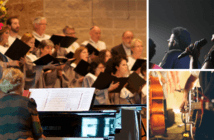Dave Brubaker says making meaning of life, providing a network of relationships, and transmitting essential values are three essential ways congregations respond to core human needs. These aspects of congregational life are key to success and may help reach “Nones” and others missing from our pews.
Meaning making and belonging are core human needs. For parents and others who care about children’s futures, another urgent need is to pass along our values to the young. While not every congregation excels at meeting all three of these needs, nearly every congregation tries. How can congregations respond to those needs both for their members and for those who are now looking elsewhere?
If we ask congregational members why they participate in congregational life, the answers often resemble one of the following: “I appreciate the worship service in this congregation.” “I come because of the people that are here.” “It’s important to me that my children are raised with the values of this community.”
These three responses reflect the three core functions of a religious congregation, regardless of the tradition to which it adheres:
1. Meaning making. Religious congregations provide a coherent worldview that invites members into a story that is larger than even the congregation or tradition of which they are a part.
2. Belonging. According to Robert Putnam in Bowling Alone (Simon & Schuster, 2000), religious congregations in the U.S. assemble more people on a weekly basis than any other type of voluntary association. Congregations offer established relational networks that, if permeable, invite visitors to affiliate with others and build meaningful relationships.
3. Values transmission. Every religious congregation either draws on some tradition with established beliefs and practices or is in the process of creating their own. Those members with children often desire to see the values that are embedded in these beliefs and practices passed on to their progeny.
Ways of Making Meaning
Meaning making, belonging, and values transmission are nearly universal human needs that congregations have traditionally met. But in recent decades, the “nones” (those who profess no religious affiliation) have come to comprise nearly a quarter of American adults — equal to the percentage of Roman Catholics or professed evangelicals. How do “nones” meet these needs?
I recently posed that question to four millennials and Gen Xers. Two, both single, are self-described “nones.” Two, both married with children, are active in a local congregation but also find meaning and belonging beyond their local congregation. Each of these individuals had a particular passion and sought to connect with others who share those (often artistic) passions — whether nature, music, movies, or dance. A large congregation may be able to offer specialty groups that bring together people with such diverse shared passions, but the great majority will struggle to do so. How might the average congregation respond to the need for meaning and belonging?
What’s a Congregation to Do?
First, keep in mind that meaning making (making sense of what often seems to be a senseless world) is a core need of those who attend our congregations. However, this does not mean supplying facile answers to difficult questions. Rather, it points to the need to help individuals locate themselves in the context of a larger, and more meaningful, story. One way to do so is to narrate a larger story and then pose a question that assists members in locating themselves. After a recent sermon on faith, the pastor of my congregation invited members to respond to the question, “When in your life did you take a leap of faith, and what was the result?” The answers were profound.
Second, remember that while the need for belonging is universal, the specific reasons for wanting to affiliate are as unique as each human being. Although the average congregation is unable to offer dozens of interest groups reflecting multiple passions, it can invite members to share those gifts with others in the congregation. This might include an offer to lead a nature hike on a Sunday afternoon, share a musical gift in a Sabbath service, or perform a liturgical dance. The goal is not to replicate the interest groups that exist in every sizeable community, but rather to welcome the expression of gifts and passions in the life of the congregation.
Congregations can be vital locations for meaning making, belonging, and values transmission. They are not, however, the only place. The ability of congregational leaders to strengthen meaning making, opportunities for belonging, and explicit values transmission are key to a successful congregation. Yet so is welcoming the experiences and learnings of those who are also finding such things outside of the congregation.
This article is adapted from “Why Congregations Exist” by David Brubaker posted to the website of the Congregational Consulting Group.Used by Permission.
Related Resources
- Be The Welcoming Church Video Tool Kit
- The “Nones” and the Spirituality of Everyday Living by Keith Anderson
- Why Typical Groups Miss Typical Members by Lovett H. Weems, Jr.






